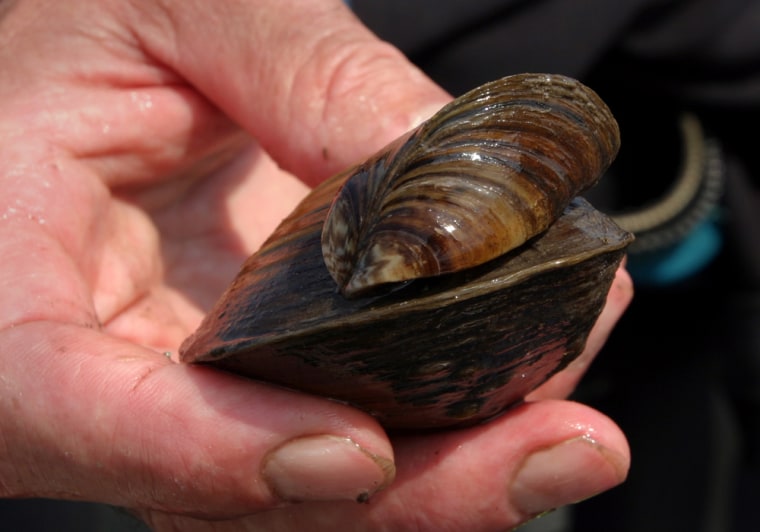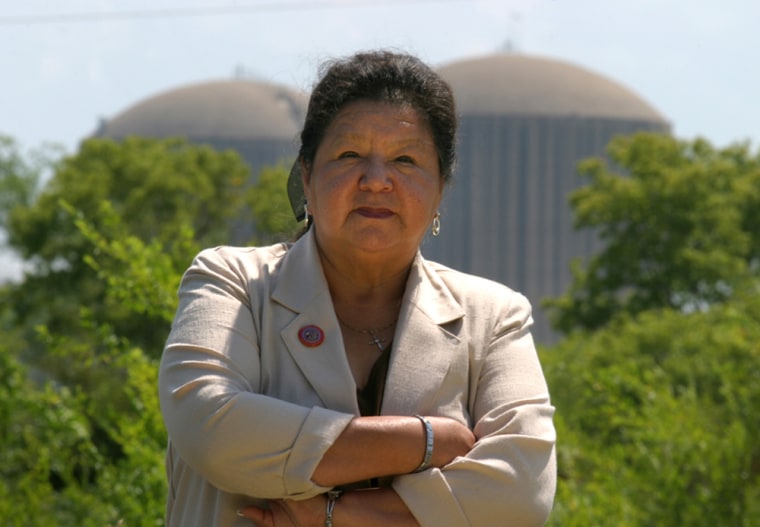The Mississippi River has as many stories as it does bends, and they come at you quicker than a speedboat bearing down on a raft when you’re trying to race from headwaters to mouth in just two weeks. On Day 2, we were the common thread between two disparate story lines spinning out on the same stretch of river – a Native American tribe that’s trying to capitalize on its good fortune and an environmental success story that is returning a long-absent native mussel to parts of the upper river.
We started our day on the southern outskirts of Minneapolis and drove about 60 miles southeast to the Prairie Island Indian Community – the only tribal reservation bordering the Mississippi River below Minneapolis.
Like every other native American tribe in the Midwest, the 650-member Prairie Island tribe was forced from its ancestral homelands along the river, its members scattered throughout the West after a brief but bloody revolt known as the Dakota Conflict in 1862. But unlike the others, the Prairie Island community reclaimed a 534-acre piece of its ancestral land about 10 miles south of Red Wing, a sandy island bordered by the Mississippi and the Vermillion rivers.
The tribe also holds a more dubious distinction – its residents apparently are the closest neighbors of a nuclear plant in the United States, with some homes just 600 yards from the twin-tower Prairie Island nuclear power plant owned by Xcel Energy.
The story of the Prairie Island Indians is one of perseverance. The tribe’s members began trickling back to the island in the late 1880s and eventually attained the critical mass that led to federal recognition of the tribe in 1936.
But with only subsistence farming and few local jobs, poverty remained a way of life for the tribe -- made up mostly of Mdewakanton Dakota Indians, or “those who were born of the waters” -- until well into the 1960s.
“My grandparents had absolutely nothing, it was abject poverty at that time,” said Doreen Hagen, president of the Prairie Island Tribal Council.
But many of the tribe’s elders remember those years fondly.

“People helped each other,” said Pauline Hamilton, a 78-year-old great-grandmother whose parents performed for a time in “Wild Bill” Hickock’s Wild West show. “I don’t ever remember going hungry. There was a lot of game and fish. The men worked for the local farmers … (in exchange for) milk and eggs and a few dollars.”
That began to change in 1984, when the tribe opened a bingo hall on the island and began attracting a trickle of residents from Red Wing and beyond. The trickle became a torrent in 1988, when the hall was expanded to become the casino-style gambling at what is now known as the Treasure Island Resort and Casino.
The casino has enabled the tribe to make much needed improvements to the infrastructure, paving roads, building a school and a health clinic staffed by doctors from the Mayo Clinic and creating a tribal police force.
It also has led to “per capita” payments – excess revenue that is sent each month to tribe members. Prairie Island officials won’t say how much each member receives, but a drive around the reservation reveals new high-end vehicles in almost every driveway.
While the money has given tribe members new opportunities, Hagen said that the biggest benefit has been to give the tribe clout with state and federal leaders for the first time.
“The casino has made it possible for us to travel to D.C. and see the representatives, and we also have lobbyists in D.C. and here in the state to help us with our issues now as well,” she said.
That influence was sorely lacking when the Prairie Island nuclear plant was built in 1968.
The unwelcome neighbor
Hagen said that tribe members were first told that the facility would be a coal-powered plant that would bring jobs to the impoverished locals. Only later did they find out that the plant was a nuclear reactor, and the jobs never materialized, she said.
Nor has the plant been a good neighbor in the intervening years, Hagen said. In one instance, there was an accident that resulted in an evacuation of the plant, but the tribe was never alerted, she said.
“The reason we found out was that all the cars were leaving,” she said. “Everyone was leaving and they forgot to tell us. Luckily we had a person who worked there who called and said, ‘You better get out.’”
The presence of the plant remains a major concern, both because there are 17 concrete “casks” with spent nuclear fuel rods stored on the grounds awaiting development of a permanent federal disposal site and because tribe members fear it could be a target for a Sept. 11 style terrorist attack.
A spokeswoman for the Nuclear Management Co. of Hudson, Wis., which operates the plant for Xcel, had no immediate comment on Hagen’s comments.
Despite continuing concern over the potentially dangerous neighbor, the most controvercial topic lately has been the tribe’s lucrative casino.
Hamilton, the tribal elder, said that some members of the tribe believe that the easy money is undermining the community’s cultural identity.
“Years ago there was caring and sharing with one another,” she said. “That’s in the past now. I don’t know what the future is, you know?”
But Hagen said the benefits of the casino far outweigh the minuses.
“We like to concentrate on the positive parts,” she said. “There are a few negative things, but nothing that we can’t overcome because we have the resources to do that.”
The 'keystone species'
Less than a mile upriver from the tribe’s new marina, river ecologist Mike Davis and two assistants are working to cement an environmental success story by reintroducing the Higgins’ eye mussel to a stretch of water where it has not been seen since the 1930s.

While the disappearance of a particular variety of mussel from the river might not seem a big loss, Davis said that the shellfish are a “keystone species” that are an important contributor to a river’s health.
“They become extremely abundant over time and they bury themselves into the sediment and become substrata of the riverbed, stabilizing the river and providing roughness that can be colonized by algae and aquatic insects that eat the algae, and then smaller fish that feed on those insects, and then of course the bigger fish,” he said. “… It creates this sort of positive feedback loop in the ecosystem.”
On this day, Davis, who works for the Minnesota Department of Natural Resources, and two crewmembers – Becky Hochstein, a student intern studying biology at St. Olaf College in Northfield, Minn., and Dan Allen, a former intern who is back for another summer on the river – are literally crawling around the bottom of the river in scuba gear, sifting the ooze with their bare hands in search of any and all mussels. The object of the search is to find out which other types of mussels are present to determine whether this is prime real estate for the Higgins’ eye as well.
The dive point in the Buffalo Slough, which runs parallel to the main channel of the Mississippi, turns out to be a mussel gold mine. In about 20 minutes of diving, Hochstein and Allen pull up bags laden with 11 species of the shellfish, known by exotic but unofficial names like the pink heel-splitter, round pig toe, pocketbook and pimple back.
That leads Davis, a weathered 55-year-old former commercial fisherman, to mark the site as a likely spot to plant Higgins’ eye mussels that he and his team are hatching using a technique perfected during the days when buttons were big industry on the river.
The project, which is funded primarily by the U.S. Army Corps of Engineers but has drawn participation from numerous state and federal agencies, aims to establish new colonies of the Higgins’ eye mussel in the upper Mississippi to hedge against the invasive non-native zebra mussel. The zebra mussel, which grows so thickly on the river bottom that it “smothers” Higgins’ eye mussels, already has spread as far north as Pepin Lake, only a few miles below where Davis and his crew are working.
Last year, the project placed 500 Higgins’ eye mussels in the upper river, and that number is due to grow to 1,500 this year and 7,500 next year, Davis said. So far, initial checks on the mussels planted last year are promising.
“They’re reproducing, whether they establish a self-sustaining community remains to be seen,” he said.
Reporter and media producer
